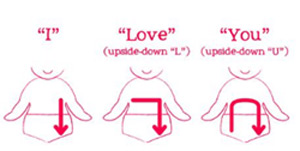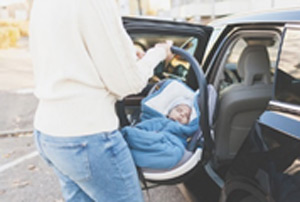Transitioning Home
For Caregivers and Premature Babies
Welcome home! This is an exciting time that can also be overwhelming. It is normal to be nervous, but you are exactly who your baby needs!
Positioning Strategies for Playtime
Belly (Prone) Positioning:
- Should only be when baby is alert and under supervision
 Recommended for 3-5 minutes 2-3 times a day as soon as you come home from the hospital
Recommended for 3-5 minutes 2-3 times a day as soon as you come home from the hospital
- Tummy time builds strength and coordination for rolling over, crawling, reaching, and playing
- Use supports under hips or chest to prevent a starfish position (top and middle photo)
- Use physical boundaries around baby to help them feel safe (bottom photo)
- Alternate head positioning between left and right
Back (Supine) Positioning:
- Keep baby’s arms and legs towards their body, to prevent a starfish position
- Add physical boundaries to help baby feel more secure (bottom photo)
 Alternate head positioning between facing up, left, and right
Alternate head positioning between facing up, left, and right
- Try using an object baby likes to encourage them to shift their head
Side Positioning:
- Use rolls to help provide boundaries (bottom photo)
- Bring baby’s hands together, to help with calming, and later hold objects
- Or, bring baby’s hand to their mouth for exploration and soothing
Rotate between sides and positions to decrease risk of flat spots on head
 Reading Baby’s Cues
Reading Baby’s Cues
Premature infants will communicate with their bodies. Understanding these signs will help you meet baby’s needs.
- Look for any changes in breathing, coloring, muscles (tensed or relaxed), crying, splaying hands, closing eyes
- To decrease stress, minimize sensory (touch, taste, smell, hearing, seeing) input and instead use sensations that mimic the womb such as: white noise, swaddle, and dim lights
- Allow baby to have new experiences on their own time, letting them decide when to continue or stop. Baby will make eye contact and have a relaxed body when they are ready for bonding
Using Massage to Support Bonding
Infant massage is great time for caregiver and baby to breathe and relax together. Take this time to engage with baby through eye contact and talking together.
Here are some simple strokes to try with lotion and a firm touch:
 Arm and leg massage:
Arm and leg massage:
- Using a “C” shape with your hands move from baby’s shoulders to their wrist
- Use thumbs to massage palm/foot from heel to fingers/toes
- Gently massage each finger or toe
Tummy massage (can aide with gas and constipation):
- The “I Love U’ stroke (diagram to the left)
- Massage baby’s tummy in a circular, clockwise motion
- Bring baby’s knees into their chest and relax; repeat 3 times
Chest massage:
- Using flat hands, stroke from the center of baby’s chest to their shoulders
- Heart massage: starting from the center of the chest, swoop up towards the shoulders, then come down and back together
- Back massage (with baby on tummy in front of you):
- With both hands, move hands back and forth along baby’s back from neck to buttocks
- Going along the spine, massage small circles on each side. Avoid pressing on the spine
Continuing Progress at Home
If your baby spent any time in the NICU, they will automatically be placed into an Early Intervention tracking program
 Calculating Adjusted Age:
Calculating Adjusted Age:
- Subtract the number of weeks early your baby was born from their actual age
- For example, if your baby was 10 weeks early, and is now 24 weeks old, their adjusted age is 14 weeks
- When considering developmental milestones, use baby’s adjusted age
Benefits of Kangaroo Care:
- Kangaroo care is skin-to-skin bonding with baby wrapped onto the caregiver’s chest
- Helps regulate baby’s temperature and heart rate
- Improves baby’s breathing pattern
- Promotes better and deeper sleep
- Helps with attachment and bonding
- Decreases risk of postpartum depression
Feeding:
- Weight gain will continue to be a priority
- Baby may require smaller, more frequent feeds
- Fortified formula may be recommended to promote brain development and weight gain
- Some spit up is common after feeds
- Read baby’s hunger cues AND consider time between feeds
 Regulating Body Temperature:
Regulating Body Temperature:
- Use layers to easily add or remove clothing to maintain appropriate body temperature
- Most heat will be lost through baby’s head, so hats can help decrease heat loss
- Bathe baby in a warm room and dry with a warm towel, because their body temperature will drop following a bath
Sleep:
- Always place baby to sleep on their back in the crib or bassinet
- Alternate the way baby’s head is facing to reduce flat spots
- Baby may sleep for more of the day (up to 22 hours), but wake more frequently for feeds
- A swaddle and white noise machine can help recreate the environment from the womb
 Do you still have QUESTIONS about YOUR BABY’S development?
Do you still have QUESTIONS about YOUR BABY’S development?
Contact TEIS Early Intervention Provider
412-271-8347
Or Text INFO to 412-543-8398


